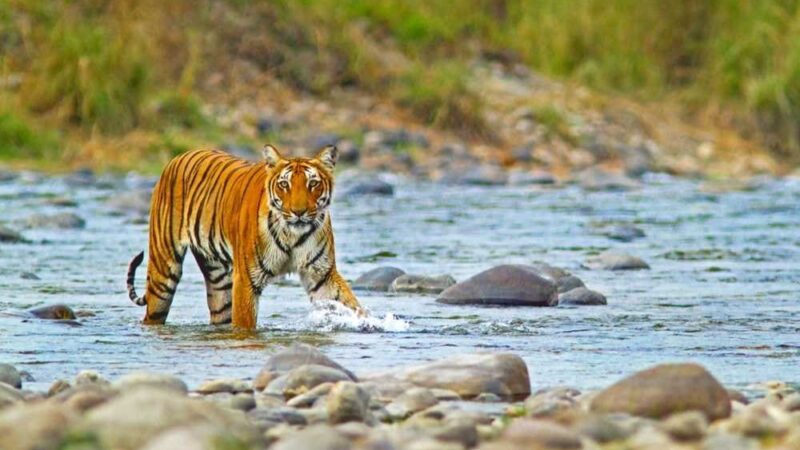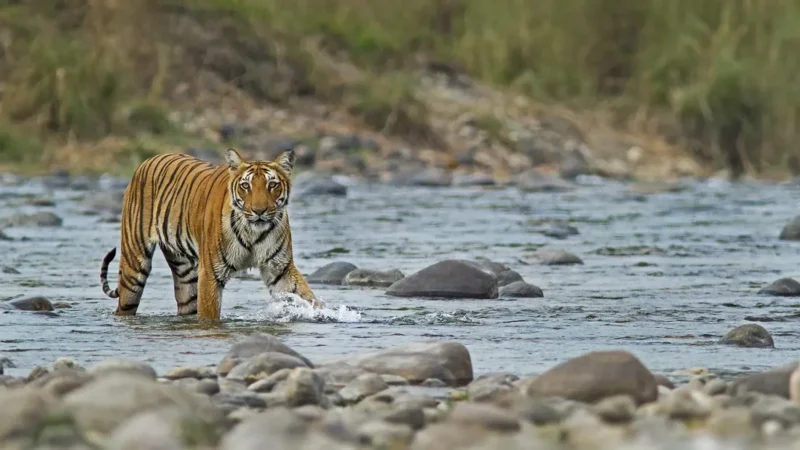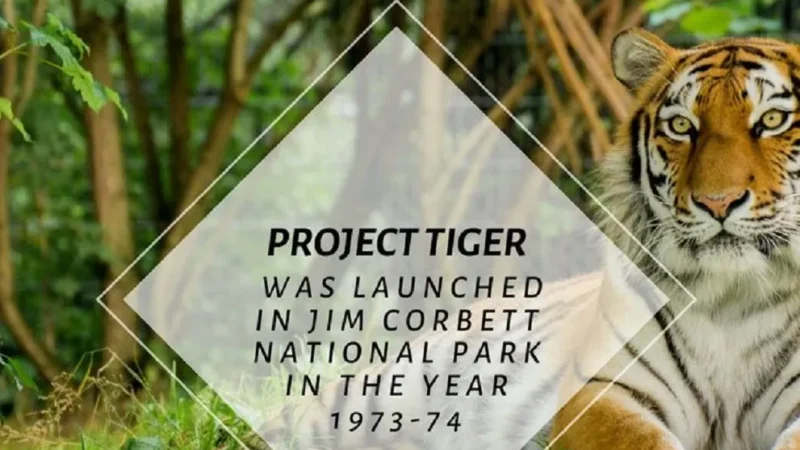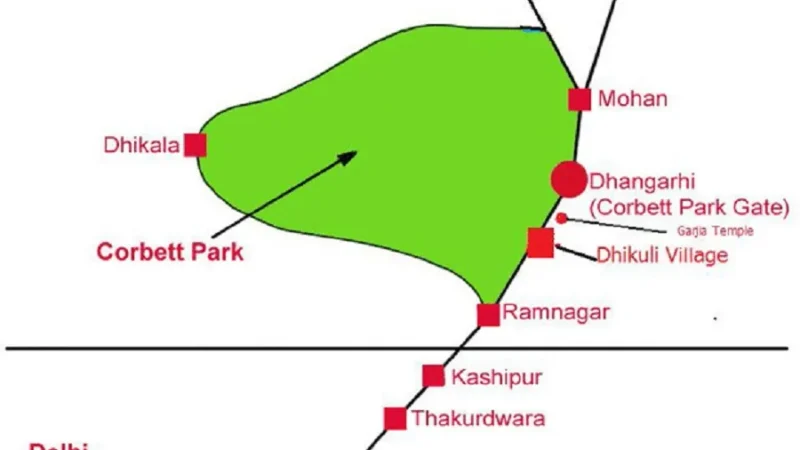Jungle Safari in Jim Corbett National Park

Table of Contents
ToggleJungle Safari in Jim Corbett -
Welcome to my blog, where we embark on an exhilarating journey through the untamed wilderness of Jim Corbett National Park. Nestled in the picturesque landscapes of Uttarakhand, India, this renowned national park is a haven for wildlife enthusiasts, nature lovers, and adventure seekers alike. Join me as we delve into the captivating world of jungle safaris in Jim Corbett, where every moment is filled with anticipation and the thrill of encountering majestic creatures in their natural habitat.
In this blog series, we will unravel the mystique of Jim Corbett National Park and provide you with valuable insights and tips for an unforgettable safari experience. From the diverse wildlife species that call this park home to the breathtaking landscapes surrounding you, each safari promises a unique and awe-inspiring adventure.
To embark on a jungle safari in Jim Corbett, you need to follow a few steps:
1- Entry Permits at Jim Corbett
You must obtain entry permits to visit Jim Corbett National Park and go on a jungle safari. Here are the general steps to acquire the permits:
- Online Booking: Visit the official website of Jim Corbett National Park or the website of the authorized booking agent. Check if online booking is available for entry permits. If yes, follow the instructions provided on the website to book your permits. Provide the necessary details, including the date of the visit, preferred safari zone, and personal information.
- On-Site Booking: If an online booking is not available or you prefer to book in person, you can obtain the entry permits from the designated entry gates of the national park. Several entry gates include the Ramnagar Gate, Jhirna Gate, and Bijrani Gate. You can reach the gate early in the morning before the safari timings to book your permits. Check the availability of permits beforehand, as there might be a limit on the number of visitors per day.
- Identification Documents: Carry your identification documents, such as a government-issued ID card (e.g., Aadhaar Card, Passport, Driver’s License), as they may be required during the permit booking process. Make sure to provide accurate information while booking the permits.
- Payment: Pay the applicable fees for the entry permits. The fees vary depending on the type of safari (jeep or canter), Indian or foreign visitors, and peak or off-peak season. The payment can be made online or in person at the entry gate, depending on the booking method.
- Confirmation: After completing the booking process and making the payment, you will receive a confirmation of your entry permits. Keep this confirmation safe, as you may be required to present it at the entry gate.
2- Safari Zones at Jim Corbett National Park
Jim Corbett National Park has multiple safari zones, offering unique landscapes and wildlife encounters. Here are the main safari zones in Jim Corbett:
- Bijrani Zone: Bijrani Zone is one of Jim Corbett National Park’s most famous safari zones. It is known for its dense forest cover, grasslands, and various wildlife species. The zone offers an excellent chance to spot tigers, elephants, deer, reptiles, and various bird species.
- Jhirna Zone: Jhirna Zone is open throughout the year and offers a picturesque landscape with hills, streams, and dense forests. It is known for its population of sloth bears and other wildlife such as deer, elephants, leopards, and a wide range of bird species.
- Dhikala Zone: Dhikala Zone is Jim Corbett National Park’s largest and most sought-after zone. It is famous for its scenic beauty, grasslands, and diverse wildlife. Dhikala offers a higher probability of spotting tigers, elephants, deer, crocodiles, and abundant birdlife. Staying overnight in Dhikala is also possible, providing a unique experience.
- Dhela Zone: Dhela Zone is a newer addition to the safari zones in Jim Corbett. Mixed forests and grasslands characterize it. The zone offers a chance to spot tigers, leopards, elephants, deer, and various bird species.
- Durga Devi Zone: Durga Devi Zone is located in the northeastern part of Jim Corbett National Park. It is less crowded and offers a tranquil atmosphere. The zone is known for its avian diversity and is an excellent spot for birdwatching. Wildlife sightings may include tigers, elephants, leopards, and various reptiles.
- Sonanadi Zone: Sonanadi Zone is situated in the national park’s buffer zone and is known for its rich flora and fauna. It offers a peaceful environment and a chance to spot wildlife such as elephants, leopards, deer, and various bird species.
Each safari zone has limited vehicles allowed during each safari slot, ensuring a regulated and sustainable wildlife viewing experience. The availability of zones may vary based on factors like seasons and maintenance activities. You should check the official website or contact the park authorities for the latest information on safari zones and their availability during your visit.
3- Safari Options at Jim Corbett National Park
Jim Corbett National Park offers two main safari options for visitors to explore the wilderness and observe the wildlife:
- Jeep Safari: Jeep safaris are the most popular and preferred option for exploring Jim Corbett National Park. These safaris provide a more intimate and personalized experience as they accommodate fewer people than canter safaris. Jeep safaris allow you to venture deep into the park’s terrain, increasing your chances of spotting wildlife up close. Each jeep usually accommodates up to 6-8 people, including the driver and a trained naturalist guide who accompany you throughout the safari. Jeep safaris are available in all the major safari zones of the park.
- Canter Safari: Canter safaris are large, open-air vehicles that can accommodate more people. These can be a good option if you’re visiting with a larger group or prefer a shared safari experience. Canters are open-sided, giving you a panoramic view of the surroundings. Canter safaris are conducted in designated safari zones and follow a fixed route. They are ideal for casual wildlife enthusiasts and photographers who want to enjoy the safari in a group setting.
Both jeep and canter safaris are accompanied by trained guides or naturalists who possess knowledge about the park’s flora, fauna, and wildlife behavior. They provide valuable insights and help in spotting and identifying various species.
4- Jim Corbett Safari Timings
The safari timings in Jim Corbett National Park can vary depending on the season and the safari zone you choose. However, here are the available timings for the safaris:
- Morning Safari: Morning safaris are conducted in two-time slots, typically from sunrise until around 10:00 AM. The exact timings may vary slightly based on the sunrise time. Morning safaris provide an opportunity to witness the jungle awakening, with higher chances of spotting wildlife as they are active during the cooler hours of the day.
- Evening Safari: Evening safaris have two-time slots, usually starting from around 2:00 PM and concluding by sunset. The exact timings may vary depending on the sunset time. Evening safaris allow you to experience the transition from daylight to dusk and observe the behavior of nocturnal animals as they begin their activities.
5- Jim Corbett Safari Charges-
The safari charges at Jim Corbett National Park can vary depending on several factors, such as the type of safari, the nationality of the visitor, and the safari zone. Here is a general overview of the safari charges:
1- Jim Corbett Entry Permit Fee:
Every park visitor has an entry permit fee. The fee varies for Indian nationals and foreign nationals. The approximate entry permit fee for Indian nationals is around INR 400-500 per person, while for foreign nationals, it is around INR 800-1000 per person. These fees are subject to change, so checking the official website or contacting the park authorities for the updated fees is advisable.
2- Jim Corbett Jeep Safari Charges:
The charges for a jeep safari in Jim Corbett National Park depend on the safari zone and the number of people sharing the jeep. Typically, a jeep can accommodate 6-8 people. The cost of a jeep safari for Indian nationals can range from around INR 4,000 to 6,000 per jeep per safari, while for foreign nationals, it can range from around INR 8,000 to 12,000 per jeep per safari. These charges include the vehicle, guide fee, and permit fee.
3- Jim Corbett Canter Safari Charges:
Canter safaris are usually more affordable compared to jeep safaris as they accommodate a larger number of people. The charges for a canter safari in Jim Corbett National Park vary based on the zone and the number of people. The approximate cost for a canter safari for Indian nationals can range from around INR 1,500 to 2,500 per person. In contrast, for foreign nationals, it can range from around INR 3,000 to 4,500 per person.
6- Accommodation near Jim Corbett
Various accommodation options are available near Jim Corbett National Park to suit different budgets and preferences. Here are some popular types of accommodations you can consider:
- Forest Rest Houses: These are government-run accommodations located within the park boundaries. They offer a unique opportunity to stay amidst nature and provide a rustic experience. Forest rest houses must be booked in advance through the official website of Jim Corbett National Park or the forest department.
- Resorts and Luxury Hotels: Several resorts and luxury hotels are located near Jim Corbett National Park. These establishments provide comfortable accommodations, modern amenities, and a range of recreational facilities. They often offer various categories of rooms, including cottages, villas, and suites, with options for dining, swimming pools, spas, and more.
- Eco-lodges and Wildlife Camps: Eco-lodges and wildlife camps are environmentally conscious accommodations that aim to blend in with the natural surroundings. They provide comfortable stay options and focus on eco-friendly practices. These lodges and camps often organize nature walks, bird watching, and other activities to enhance your wildlife experience.
- Guesthouses and Homestays: Guesthouses and homestays are available in nearby villages and towns, offering a more personalized and local experience. These accommodations are typically run by residents and provide a chance to interact with the community and learn about the local culture.
7- Wildlife Encounters in Jim Corbett
Jim Corbett National Park is renowned for its rich biodiversity and offers incredible wildlife encounters. Here are some of the iconic species you can expect to encounter during your safari:
- Royal Bengal Tiger: Jim Corbett is famous for its population of Royal Bengal Tigers. These magnificent big cats are the park’s pride; spotting them in their natural habitat is a thrilling experience. Although elusive, the park provides a favorable habitat for tigers, increasing the chances of tiger sightings.
- Asiatic Elephant: The park is also home to a significant population of Asiatic Elephants. These gentle giants can often be spotted near water bodies or while grazing. Observing these majestic creatures up close is a memorable experience.
- Leopards: Known for their agility and stealth, leopards inhabit the forests of Jim Corbett National Park. Though secretive, they occasionally appear, especially during early morning or late evening safaris. Spotting a leopard in the wild is a rare and exciting sighting.
- Sloth Bear: Jhirna Zone of the park is known for its sloth bear population. These shaggy-coated bears can be observed foraging for food or climbing trees searching for honey. They are fascinating creatures to encounter during a safari.
- Spotted Deer and Sambhar Deer: Jim Corbett National Park is home to various species of deer, including the Spotted Deer (also known as Chital) and Sambhar Deer. These graceful animals can be seen grazing in open grasslands or seeking shade under the trees.
- Wild Boar: The wild boar’s distinctive appearance and robust build can be spotted in Jim Corbett. These omnivores are often seen foraging for food in the forested areas.
- Reptiles: Jim Corbett is home to various reptiles, including the Indian Marsh Crocodile and Gharial, which can be found near the rivers and water bodies within the park. Keep an eye out for these fascinating reptiles basking in the sun.
- Avian Diversity: The park boasts remarkable avian diversity, making it a paradise for birdwatchers. Over 600 bird species have been recorded in the area, including the majestic Great Hornbill, colorful Indian Pitta, and endangered species like the White-rumped Vulture. Bird enthusiasts will be delighted by the vibrant array of feathered inhabitants.
Conclusion -
A jungle safari in Jim Corbett National Park is an experience that leaves a lasting imprint on your soul. It is a journey into the heart of nature, where you become one with the untamed wilderness and witness the wonders of the animal kingdom. The park’s rich biodiversity, encompassing iconic species like the Royal Bengal Tiger, Asiatic Elephant, and elusive leopards, offers an exciting opportunity to connect with nature in its rawest form.
As you traverse the safari zones of Jim Corbett, you are immersed in a world where time stands still, and each moment brings the anticipation of a remarkable wildlife encounter. Whether it’s the sight of a tiger stealthily creeping through the undergrowth, the gentle swaying of an elephant as it grazes by the river, or the elusive presence of a leopard hidden amidst the trees, each sighting is a testament to the beauty and resilience of the natural world.
Beyond the thrill of wildlife sightings, a jungle safari in Jim Corbett also allows you to appreciate the intricate ecosystems that thrive within the park. The symphony of bird calls, the rustle of leaves, and the fragrance of the forest create an immersive experience that renews your connection with the Earth.
As we conclude our journey through the wilderness of Jim Corbett, let us carry the spirit of conservation, appreciation, and respect for nature with us. May the echoes of the roaring tigers, the trumpeting elephants, and the melodic bird songs continue to inspire us to protect and cherish the natural treasures Jim Corbett National Park and other wild places hold.






